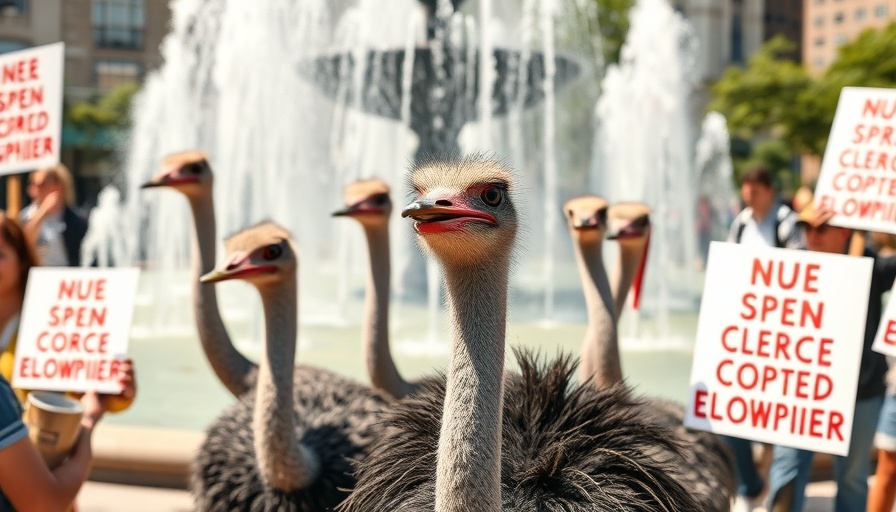
A Controversial Decision: The Fight Against the Cull of B.C.’s Ostriches
A growing wave of protest is rising from the picturesque landscapes of British Columbia, where nearly 400 ostriches at a farm in Edgewood face culling due to a recent federal court ruling. The Canadian Food Inspection Agency (CFIA) has ordered the destruction of these birds, following an outbreak of avian flu that affected a flock last year. However, the owners of the Universal Ostrich farm assert that the remaining birds have shown no signs of illness and have achieved herd immunity, igniting public outrage and passionate protests among local residents.
The Emotional Core of the Issue
On a crisp Thursday morning, around 20 demonstrators took to the streets of Vernon to voice their discontent over the court’s decision. Protesters held signs and chanted slogans emphasizing the inherent rights of the ostriches, dubbed by some as ‘victims of circumstance.’ Gena Barzan, who organized the rally, emphasized the emotional toll on both the birds and the farming community, declaring, "It’s absolutely absurd to murder them, and that’s what it is, it’s murder." This sentiment resonates deeply within a community that values both animal welfare and responsible farming practices.
The Spread of Avian Flu: Causes and Responsibility
The avian flu outbreak that led to this drastic measure stemmed from a flock of migrating ducks, highlighting the interconnectedness of wildlife and domesticated animals. The CFIA's decision is based on a precautionary principle aimed at preventing further spread of the virus. However, many locals argue that the measures taken do not reflect the current health status of the ostriches. “We will stand our ground. We will be here until the end,” stated Colin Bigbear, a farm supporter who posted on social media with determination, reinforcing the community's resolve to protect their feathered friends.
Public Backlash: Perspectives from Social Media
The growing frustration has permeated social media platforms, where individuals express their outrage and disappointment at the federal decision. Memes, hashtags, and personal stories surround the situation, painting a vivid picture of public sentiment. Many people see it as an overreach of bureaucratic power. The backlash emphasizes a broader discussion about governmental roles in regulating agriculture and wildlife, especially when the local community feels misrepresented and misunderstood.
Animal Rights and Farming: A Balancing Act
This incident raises significant questions about the balance between animal rights and agricultural practices. Situations like this showcase a tension that often permeates discussions around farming and the ethical treatment of animals. On one hand, there’s a clear need for regulations intended to protect both animal health and food safety. On the other hand, there’s the perspective that such regulations can sometimes lead to extreme actions without sufficient cause, especially if the animals in question are not exhibiting symptoms of illness.
The Local Economy’s Stake in the Outcome
The ostrich farm isn't just home to these birds; it’s a part of the local economy. Should the cull proceed, it will not only impact the lives of the ostriches but also the livelihoods of those in the farming community who rely on this enterprise for economic stability. The farm contributes to local tourism, agriculture, and the economy at large, making the stakes incredibly high for the community members who embody this reality every day.
Analyzing the Future: Will Animal Rights Prevail?
As more individuals rally to support the owners of the farm, questions about future implications arise. Will this protest influence policy changes or future regulations surrounding animal culling? The public's response may pave the way for more humane animal treatment and foster dialogue over establishing clear guidelines on what qualifies as necessary intervention in agricultural practices. The community's growing voice could potentially lead to avenues of change that align more closely with both animal welfare and agricultural viability.
Conclusion: A Community Standing Together
This unfolding situation is a testament to the power of community and collective action. As residents come together to protect what they believe is right, their solidarity advocates not just for the ostriches but stresses a larger systemic need for dialogue between animal rights advocates and agricultural entities. The voices against this cull highlight the complexities inherent in balancing human needs with ethical considerations for animal welfare. Awareness of such issues calls for ongoing advocacy and a reassessment of how society values both human and animal life in agricultural settings. Let us continue to engage in meaningful conversations about our responsibility towards animals as we navigate the spaces they share with us.
 Add Row
Add Row  Add
Add 




 Add Row
Add Row  Add
Add 

Write A Comment